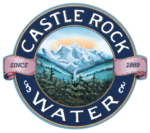There’s a lot of bottled water in this country.
In fact, bottled water is set to overtake soda as America’s top-selling packaged beverage. That’s great for the health of our people, but it opens it up a lot of questions about water, its packaging, how it’s obtained, where it’s sourced, what country it comes from, and the companies that sell it.
One of the largest items of contention in the bottled water industry is the fact that water is available, at little to no cost, from the tap of nearly every home and building in America. Why should people pay for water in a bottle?
We’ll answer that question here and compare municipal water to spring water. Over the next few blogs in this series, we’ll also talk about large corporate bottlers versus small family owned bottlers, imported water, the social and environmental responsibilities of water bottlers, how Castle Rock Water stands out in the mass of bottlers, and, of course, we’ll tie it all together with the importance of American-sourced water.
First though, let’s look at how city water is obtained, treated, and stored before it comes out of your kitchen faucet.
In most cases, cities place intake pipes at deep parts of a river or lake, so as to avoid drawing in oil and other debris floating on the surface. Some cities pump water from underground aquifers.
That raw water is pumped to temporary holding ponds, where the water is allowed to settle and let some of the solids drop out. Sometimes it is pumped directly to a treatment plant. A coagulant is often added at this stage, which creates clumps of particles in a process called flocculation.
These clumps are then allowed to settle to the bottom of a basin, where the sludge is removed.
The water is then filtered and treated, sometimes with chemicals such as chlorine and fluoride, then delivered to you.
Water that is treated extensively and allowed to sit stagnate loses its energy, its vitality, and its structure. The water essentially dies and all beneficial minerals and electrolytes are lost. Tap water in most municipalities is not unhealthy, but it’s not going to provide the benefits that nature intended either.
Castle Rock Water, on the other hand, is pure living structured water. The water is never touched by humans, it’s not artificially filtered or modified, and it never sits stagnant. Nothing is ever added. Castle Rock Water starts as glacier melt on the top of the mountain and is filled with oxygen isotopes. It spends the next 100-10,000 years percolating through the mountain, which acts as one of the largest water filters in the world. This ancient water flows through lave tubes, streams, moves over precious metals and stones, and twists and turns down the banks of Mt. Shasta, right here in America.
The water becomes energized on its journey. Because it’s constantly moving and naturally filtered as it flows, it gains structure and is infused with many beneficial minerals and natural electrolytes from the material deep inside the mountain. The body uses these minerals to stay properly hydrated.
Tap water isn’t necessarily bad, but there are people who want to know exactly what is going into their bodies and want the very best water to nourish them and keep them healthy. Those are the people who drink American-sourced Castle Rock Water.
Are you one of them?


I’m in love with this water. I’m so happy you guys exist. 🙂
Thanks, Dave!
Pingback: American Sourced: Where Is the Best Bottled Water in the World? | Castle Rock Water Co.